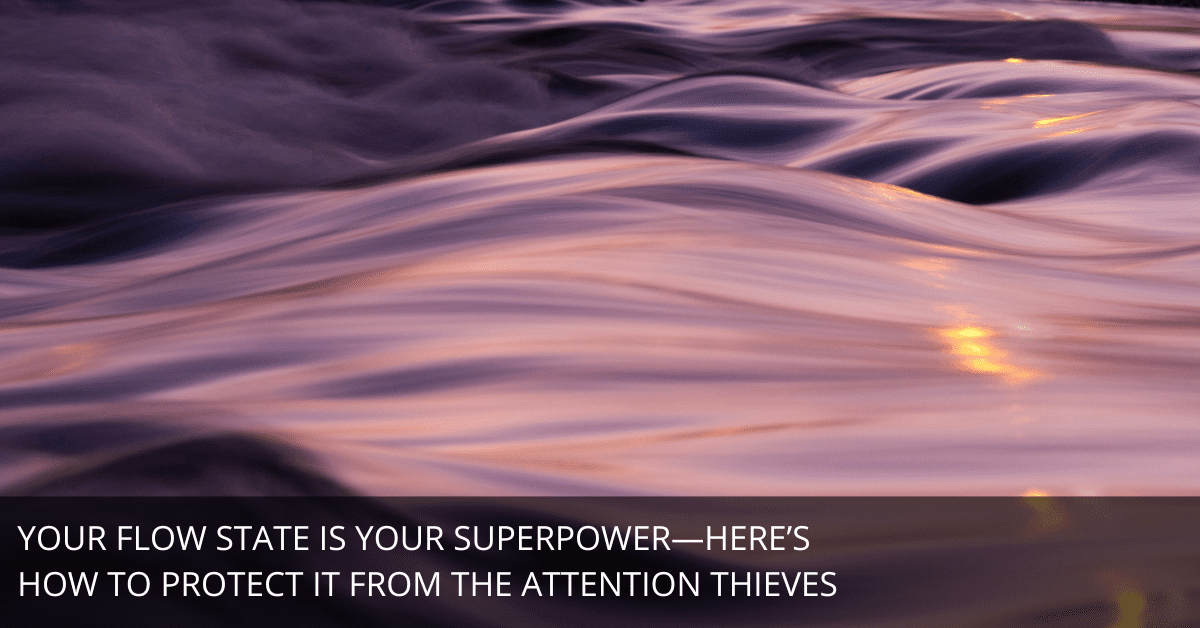
There’s a reason you feel more scattered than ever.
Your attention is under attack.
Every time you open an app, scroll through social media or even glance at your phone, you’re stepping into a battlefield designed to hijack your focus and keep you locked in a cycle of distraction.
It wasn’t always this way.
Once upon a time, flow states—those beautiful moments of effortless focus and deep engagement—were ours to experience freely. Jazz musicians lived for it. Athletes thrived on it. Artists, writers, and anyone who lost themselves in meaningful work knew what it felt like. Flow made time disappear. It made the impossible feel easy. It was, and still is, one of the most powerful tools for creativity and performance.
But then, someone figured out they could monetize it. And now? Flow isn’t something we stumble into naturally. It’s something that’s being sold back to us in the form of infinite scroll, autoplay, and algorithm-driven engagement loops designed to keep us hooked.
If you want to take back control, you must understand what’s happening and, more importantly, what to do about it.
Why Flow Matters (and Why It’s Under Attack)
Flow isn’t just about peak performance. It’s about feeling fully alive—being so immersed in an activity that everything else fades away. It’s how jazz musicians improvise at the highest levels. It’s how writers get lost in their words. It’s why kids can play for hours without noticing the time.
But today, corporations have hijacked the mechanics of flow for profit. The same mental state that makes creating music effortless is now used to keep you swiping on TikTok, gambling at a digital casino, or binge-watching an entire season of a show in one sitting. The tech industry has turned flow into a weaponized addiction loop, keeping you engaged just long enough to serve you another ad.
If you feel drained at the end of the day but are unsure why, this is it. Your natural flow state is being stolen and sold to the highest bidder.
How to Recognize When Your Flow is Being Manipulated
Before you can break free, you have to spot the traps. Here’s how you know you’re in a manipulated flow state:
- You open an app for “just a second” and lose 30 minutes.
- You feel the urge to refresh a feed or check notifications without thinking.
- You keep swiping, watching, or scrolling because it’s easier than stopping.
- You feel empty or restless when you’re not engaging with a screen.
Sound familiar? That’s by design.
The same dopamine-driven loops that make gambling addictive are being used in social media and entertainment platforms. And the worst part? These systems aren’t just stealing your time. They’re rewiring your brain to crave more of it.
Step 1: Cut Off the Manipulation Loops
If you’re serious about reclaiming your flow, you must break the cycle. Here’s how:
- Turn Off Autoplay & Notifications
- Kill the endless video loops on YouTube and Netflix.
- Disable “infinite scroll” extensions in your browser.
- Set notifications to essential only—no random pings from apps trying to re-engage you.
- Put Up Friction Between You and the Algorithm
- Move social media apps off your home screen.
- Log out after every use so it takes extra effort to get back in.
- Use website blockers like Freedom or Cold Turkey to limit access.
- Audit Your Digital Habits
- Check your screen time stats. You might be shocked at how much time is slipping away.
- Identify the biggest offenders—TikTok? Instagram? YouTube?—and set time limits.
The goal here isn’t to eliminate digital entertainment. It’s to stop it from hijacking your attention before you even realize it’s happening.
Step 2: Rebuild Real Flow (The Kind That Actually Feeds You)
Once you’ve cut out the noise, you need to replace it with activities that create genuine, fulfilling flow states. Here’s how to get back to real, unmonetized flow:
- Find Your Natural Flow Triggers
- Think about the last time you were so deep in something that time disappeared. Was it playing an instrument? Writing? Running? Sketching?
- Make a list of activities that naturally engage you and don’t involve a screen.
- Schedule Deep Work & Play Time
- Block out at least 90 minutes for an activity that challenges and excites you.
- Treat it like a meeting—no distractions, no multitasking, just complete immersion.
- Create a Ritual to Enter Flow Faster
- Play the same song before starting a deep work session.
- Use physical movement—like stretching or breathing exercises—to transition into focus.
- Keep a dedicated space for creative work that’s free of digital distractions.
Step 3: Protect Your Flow Like Your Life Depends on It
Because, in a way, it does. If you don’t take control, someone else will.
Here’s how to build a fortress around your flow state so it doesn’t get hijacked again:
- Set Non-Negotiable Tech-Free Zones
- No phones in the bedroom. (Your sleep and mental clarity will thank you.)
- No screens during meals. (This alone can restore your attention span.)
- Block social media during deep work hours. (Apps like Freedom can make this automatic.)
- Train Yourself to Notice Flow Disruptors
- If you find yourself reaching for your phone impulsively, pause and ask why.
- Recognize when you’re being pulled into passive consumption instead of active engagement.
- Get comfortable with boredom—it’s often the gateway to real creativity.
- Encourage Others to Do the Same
- Share this approach with friends and family.
- Set up “flow-friendly” activities with others—jam sessions, deep work sprints, creative meetups.
- The more people around you who value real flow, the easier it is to stay on track.
Final Thoughts: Flow is Freedom (But You Have to Fight for It)
The world isn’t going to stop trying to hijack your attention. The question is, are you going to let them?
Reclaiming your flow isn’t just about getting more done. It’s about living on your own terms—choosing where your focus goes instead of letting tech companies decide for you.
So start small. Turn off autoplay. Block distractions. Find one activity this week that pulls you into real, fulfilling flow.
Because the second you stop handing your attention over to someone else, you take your power back.
And that’s worth everything.
FAQ: Reclaiming Your Flow (And Why It Matters)
1. “I don’t think social media or tech is stealing my focus. I just have bad self-discipline.”
It’s not just about willpower. Social media platforms, apps, and streaming services are designed to hijack your attention using the same psychological tricks as casinos. They exploit dopamine-driven feedback loops to keep you engaged longer than you intend. The solution isn’t just “more discipline”—it’s creating an environment where focus is the default by setting up friction against distractions.
2. “I use social media for work—I can’t just quit.”
That’s fair. The goal isn’t to eliminate social media entirely but to use it on your terms instead of letting it use you. Schedule specific times for social media instead of checking it impulsively, remove it from your home screen, and log out after each session. You’ll still get what you need from it—without falling into endless scroll traps.
3. “I unwind by watching YouTube and Netflix. Isn’t that okay?”
Absolutely—entertainment isn’t the enemy. The problem is when autoplay and algorithm-driven recommendations turn passive watching into an hours-long time sink. A simple fix? Turn off autoplay and set intentional limits for viewing so you control the content instead of the platform controlling you.
4. “Isn’t this just another version of ‘quit social media and go touch grass’?”
Not at all. This isn’t about quitting tech—it’s about using it intentionally. You don’t have to ditch your phone, but you should be aware of when it’s stealing your focus instead of serving you. Tech should be a tool, not a trap.
5. “I need notifications for work and personal life. Turning them off isn’t realistic.”
You don’t have to turn off everything—just prioritize what’s truly essential. Keep notifications for calls, texts, and urgent messages, but disable notifications for social media, news, and apps that constantly pull your attention. If something is important, they will call you.
6. “I can’t just block distractions—I need something to replace them.”
Exactly. Cutting out distractions isn’t enough—you need to replace them with real flow activities. The key is to identify activities that naturally engage you (music, writing, exercise, deep work) and schedule them intentionally. Otherwise, the vacuum left by cutting distractions will just pull you back in.
7. “I thrive in chaos. I don’t need structured deep work time.”
If you’re getting the results you want, great! But most people think they work well in chaos while constantly feeling scattered and overwhelmed. Try structured focus sessions for a week—90-minute deep work blocks, no distractions—and see if your productivity and creativity improve.
8. “I need my phone for everything. How can I possibly detach?”
Phones are powerful tools—but that’s the problem. They do everything, which means they also distract you from everything. The goal isn’t to abandon your phone but to control how and when you use it. Set app limits, use “Do Not Disturb” during deep work, and physically separate your phone from your workspace when you need focus.
9. “I don’t have time for deep work or creative play.”
If you have time to check Instagram, binge-watch a show, or scroll TikTok, you have time for deep work. The difference is intentionality—those platforms steal time in micro-moments, adding up to hours. Start by replacing just 30 minutes a day with an activity that puts you in real flow. You’ll see the difference.
10. “Tech isn’t the problem—people just need better self-control.”
That’s exactly what Big Tech wants you to think. The reality? Tech companies hire neuroscientists, behavioral psychologists, and data analysts to make their platforms as addictive as possible. This isn’t about individual weakness—it’s about an unfair fight. The solution isn’t just more self-control, but better systems to protect your focus.
Bottom line: You don’t have to quit tech, delete social media, or live in a cave to reclaim your flow. You just have to make small, intentional changes to stop letting tech companies control your focus—and start using your attention for what truly matters.

